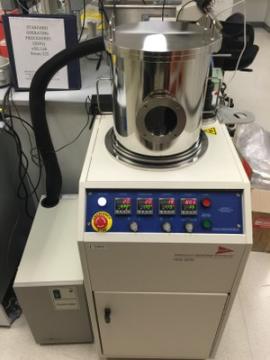PDS 2010 LABCOTER™ 2 Parylene Deposition System (parcoater)
Overview

The Labcoter™ 2 (PDS 2010) a portable Parylene coater. It is designed for the occasional Parylene user, and is ideal for experimentation and small production runs. Parylene is a unique polymer consisting of a linear chain of Benzene rings with two Methylene groups replacing 2 Hydrogen atoms on opposite sides of the Benzene ring serving as coupling links for the polymer. This film has become known for its imperviousness to water transmission which enables device protection from environmental deterioration via encapsulation and also for its electrical characteristics which are useful for micro-electrical circuitry. The source material for the deposited film is a dimer form of the parylene molecule in which two monomers are coupled in parallel by the Methylene ends. The dimer is sublimated in a Vaporizer chamber, broken into monomer molecules in the Pyrolizer furnace and then deposited as long chain polymers on substrates in the deposition chamber. Parylene has three primary variations—C, N, and D. The equipment settings and final product properties differ slightly for each variation. Detailed information on the properties is available upon request or at web site Other links: A compilation of parylene physical properties that was compiled by Dr. Tao Wu PDS 2010 Labcoater 2 Parylene Deposition System manual provided by the vendor Instructions that should be next to the Parylene Coater in Room 155 The Deposition Process The Parylene polymers are deposited from the vapor phase by a process that resembles vacuum metallizing. Unlike vacuum metalization, which is conducted at pressure of 1x10-5 Torr or below, the Parylenes are formed at around 1x10-2 Torr. Unlike vacuum metallizing, Parylene deposition is not line-of-sight and all sides of an object to be encapsulated are uniformly impinged by the gaseous monomer. This is responsible for the truly conformal nature of the coating. The deposition process consists of the following steps done in the presence of a medium vacuum: 1. Vaporization: Parylene is vaporized from its solid dimer form. This is accomplished by the application of heat under vacuum. NOTE: The appropriate term for passing directly from a solid to a gas is sublimation. However, the industry has conventionally used the term vaporization in conjunction with the Parylene process. This convention is maintained throughout this manual. 2. Pyrolysis (cleaving) of the gaseous form of the dimer into a monomer is achieved by using a high temperature tube furnace. 3. Polymerization of the gaseous monomer occurs at room temperature as the Parylene deposits as a polymer onto the substrate in the vacuum chamber.
Cleanliness:
Processing Technique(s)
Capabilities and Specifications
Lab Supplied Materials
Substrate Type
Substrate Sizes
Lab Facility, Location, and NEMO Information
Lab Facility:
Location:
NEMO Area (ExFab by room):
NEMO ID:
parcoater
Training and Maintenance
Lab Facility:
Training Charges:
3.00 hours
Primary Trainer:
Backup Trainer(s):
Primary Maintenance:
Backup Maintenance:
Steps to become a tool user
-
Become a member of SNF.
- Study the relevant operating procedures:
- Contact the primary trainer: Gabe Catalano


